The Application of Accounting Standards
VerifiedAdded on 2023/01/12
|10
|2450
|82
AI Summary
This report analyzes the application of accounting standards in the annual report of Woolworths Group. It discusses major issues in the application of IFRS, IFRS application in non-current asset reporting, and trends in asset values.
Contribute Materials
Your contribution can guide someone’s learning journey. Share your
documents today.
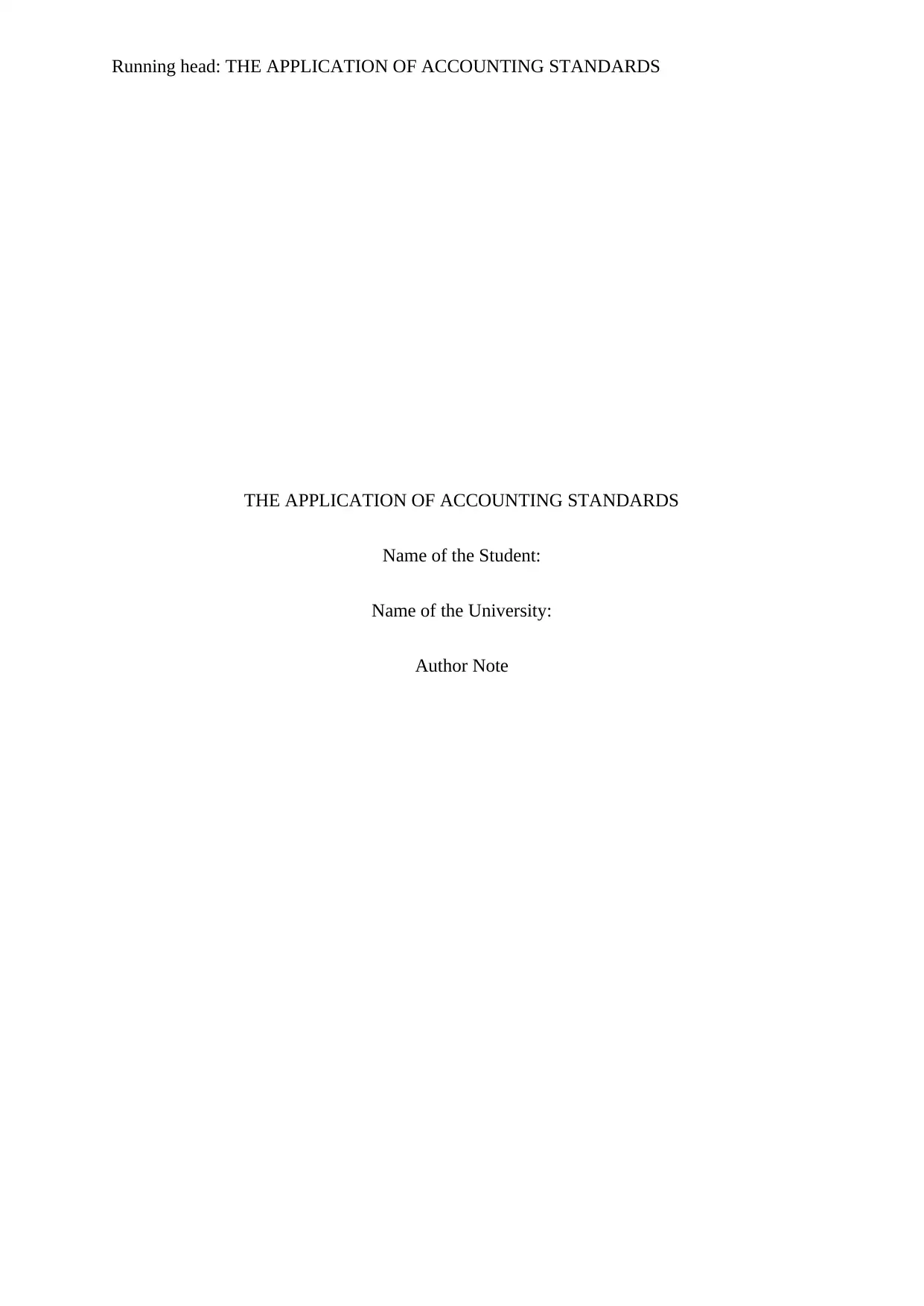
Running head: THE APPLICATION OF ACCOUNTING STANDARDS
THE APPLICATION OF ACCOUNTING STANDARDS
Name of the Student:
Name of the University:
Author Note
THE APPLICATION OF ACCOUNTING STANDARDS
Name of the Student:
Name of the University:
Author Note
Secure Best Marks with AI Grader
Need help grading? Try our AI Grader for instant feedback on your assignments.
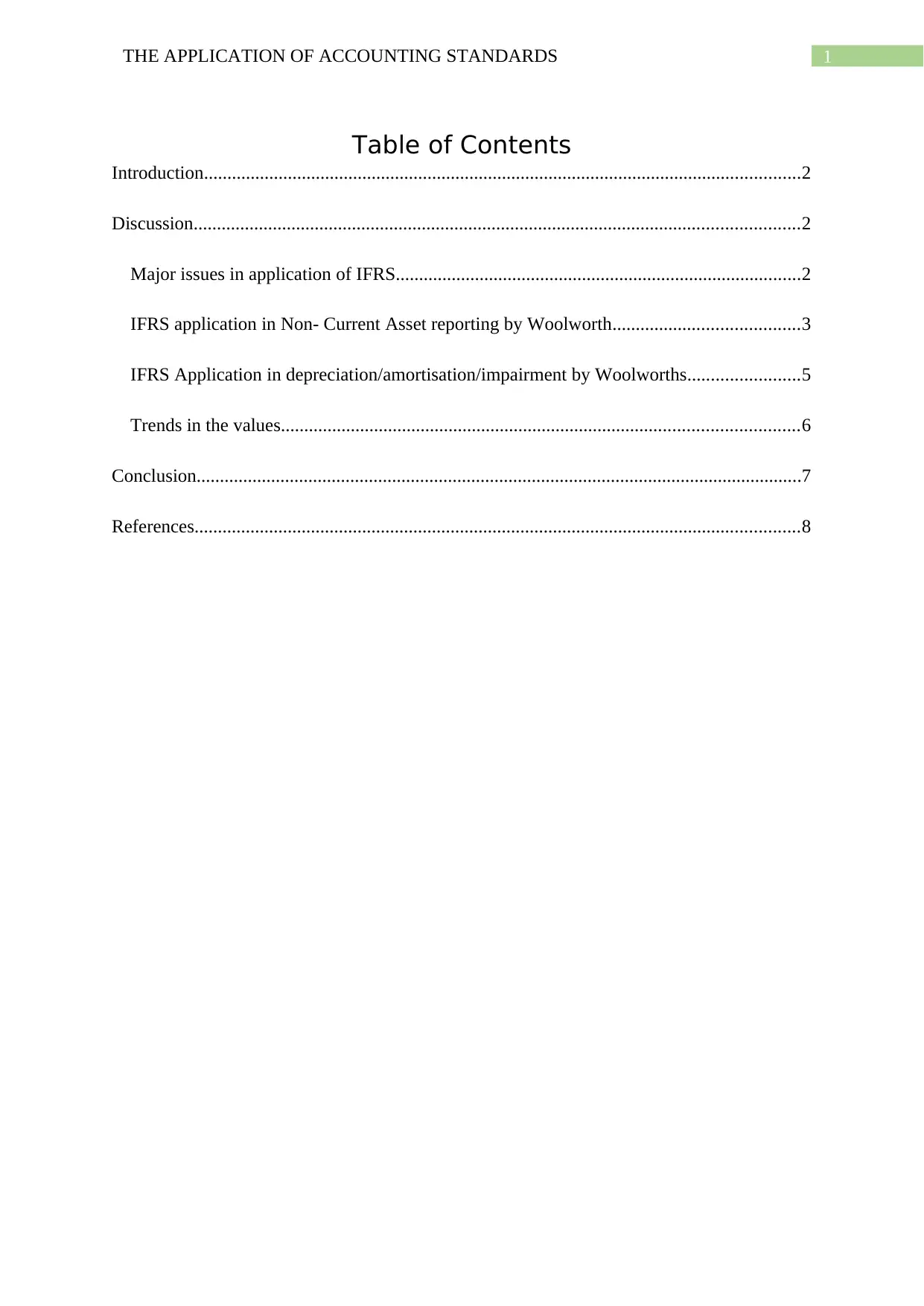
1THE APPLICATION OF ACCOUNTING STANDARDS
Table of Contents
Introduction................................................................................................................................2
Discussion..................................................................................................................................2
Major issues in application of IFRS.......................................................................................2
IFRS application in Non- Current Asset reporting by Woolworth........................................3
IFRS Application in depreciation/amortisation/impairment by Woolworths........................5
Trends in the values...............................................................................................................6
Conclusion..................................................................................................................................7
References..................................................................................................................................8
Table of Contents
Introduction................................................................................................................................2
Discussion..................................................................................................................................2
Major issues in application of IFRS.......................................................................................2
IFRS application in Non- Current Asset reporting by Woolworth........................................3
IFRS Application in depreciation/amortisation/impairment by Woolworths........................5
Trends in the values...............................................................................................................6
Conclusion..................................................................................................................................7
References..................................................................................................................................8
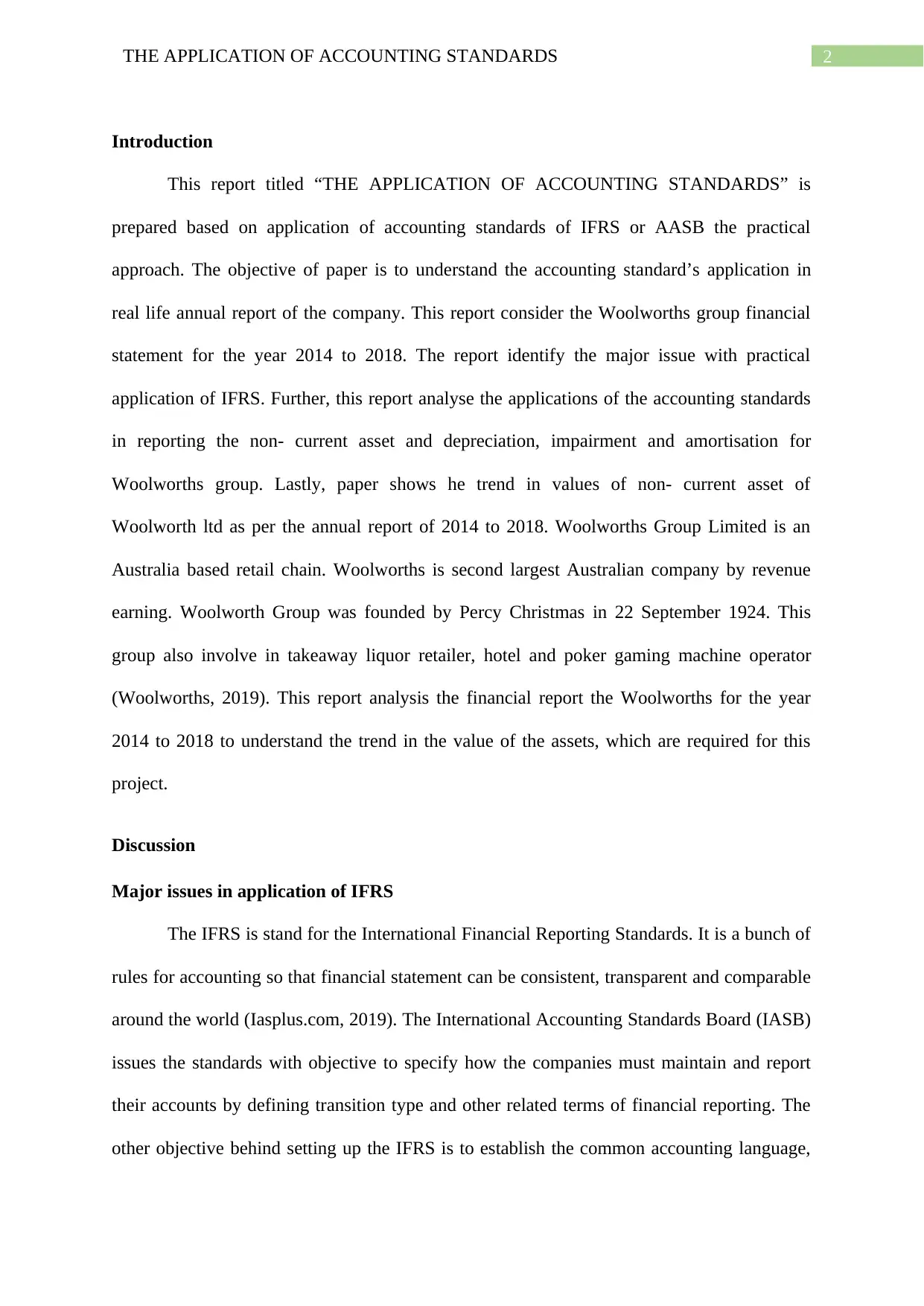
2THE APPLICATION OF ACCOUNTING STANDARDS
Introduction
This report titled “THE APPLICATION OF ACCOUNTING STANDARDS” is
prepared based on application of accounting standards of IFRS or AASB the practical
approach. The objective of paper is to understand the accounting standard’s application in
real life annual report of the company. This report consider the Woolworths group financial
statement for the year 2014 to 2018. The report identify the major issue with practical
application of IFRS. Further, this report analyse the applications of the accounting standards
in reporting the non- current asset and depreciation, impairment and amortisation for
Woolworths group. Lastly, paper shows he trend in values of non- current asset of
Woolworth ltd as per the annual report of 2014 to 2018. Woolworths Group Limited is an
Australia based retail chain. Woolworths is second largest Australian company by revenue
earning. Woolworth Group was founded by Percy Christmas in 22 September 1924. This
group also involve in takeaway liquor retailer, hotel and poker gaming machine operator
(Woolworths, 2019). This report analysis the financial report the Woolworths for the year
2014 to 2018 to understand the trend in the value of the assets, which are required for this
project.
Discussion
Major issues in application of IFRS
The IFRS is stand for the International Financial Reporting Standards. It is a bunch of
rules for accounting so that financial statement can be consistent, transparent and comparable
around the world (Iasplus.com, 2019). The International Accounting Standards Board (IASB)
issues the standards with objective to specify how the companies must maintain and report
their accounts by defining transition type and other related terms of financial reporting. The
other objective behind setting up the IFRS is to establish the common accounting language,
Introduction
This report titled “THE APPLICATION OF ACCOUNTING STANDARDS” is
prepared based on application of accounting standards of IFRS or AASB the practical
approach. The objective of paper is to understand the accounting standard’s application in
real life annual report of the company. This report consider the Woolworths group financial
statement for the year 2014 to 2018. The report identify the major issue with practical
application of IFRS. Further, this report analyse the applications of the accounting standards
in reporting the non- current asset and depreciation, impairment and amortisation for
Woolworths group. Lastly, paper shows he trend in values of non- current asset of
Woolworth ltd as per the annual report of 2014 to 2018. Woolworths Group Limited is an
Australia based retail chain. Woolworths is second largest Australian company by revenue
earning. Woolworth Group was founded by Percy Christmas in 22 September 1924. This
group also involve in takeaway liquor retailer, hotel and poker gaming machine operator
(Woolworths, 2019). This report analysis the financial report the Woolworths for the year
2014 to 2018 to understand the trend in the value of the assets, which are required for this
project.
Discussion
Major issues in application of IFRS
The IFRS is stand for the International Financial Reporting Standards. It is a bunch of
rules for accounting so that financial statement can be consistent, transparent and comparable
around the world (Iasplus.com, 2019). The International Accounting Standards Board (IASB)
issues the standards with objective to specify how the companies must maintain and report
their accounts by defining transition type and other related terms of financial reporting. The
other objective behind setting up the IFRS is to establish the common accounting language,

3THE APPLICATION OF ACCOUNTING STANDARDS
so it can be easily understandable from country to country and company to company.
However, as like anything, it also have some drawbacks (Doupnik & Perera, 2017). The
major issues in application of IFRS are mention further. While applying the IFSR the
company may face following issue: -
The application processes of the IFSR is complex and
Company need time to apply the IFSR fully in their accounting reporting method
as well as it needs too much money to apply them, as this change requires
extensive work of an auditor and other qualified accountant (Evans et al., 2015).
This is the expectation that the IFSR increase the provision and therefore would
affect IFSR capital and the potentially could even affect covenants in external
financing agreements (Ball, 2016).
Ti is difficult to adopt the new standard for any company as the many accounting
terms are carried forward and write off in several coming years.
This IFSR can change the entire accounting structure of the, which deeply affect
company’s performance in related to the finance.
An accountant and internal or external auditor of the firm will face many issues, as
the method is new to them and need to learn many new things in order to perform
their duty.
IFRS application in Non- Current Asset reporting by Woolworth
The non- current assets are the investment for long terms of the company that value is
not realized in single accounting period like leased property, tangible assets, owned property
and intangible assets. This appears in the balance sheet of the company in annual report
(IFRS 5, 2019). As per the Woolworths Group’s finance annual report for the year 2018,
states that complaining with the Australian Accounting Standards (AAS) make sure financial
annual Report compile with International Financial Reporting Standards (IFRS) as adopted
so it can be easily understandable from country to country and company to company.
However, as like anything, it also have some drawbacks (Doupnik & Perera, 2017). The
major issues in application of IFRS are mention further. While applying the IFSR the
company may face following issue: -
The application processes of the IFSR is complex and
Company need time to apply the IFSR fully in their accounting reporting method
as well as it needs too much money to apply them, as this change requires
extensive work of an auditor and other qualified accountant (Evans et al., 2015).
This is the expectation that the IFSR increase the provision and therefore would
affect IFSR capital and the potentially could even affect covenants in external
financing agreements (Ball, 2016).
Ti is difficult to adopt the new standard for any company as the many accounting
terms are carried forward and write off in several coming years.
This IFSR can change the entire accounting structure of the, which deeply affect
company’s performance in related to the finance.
An accountant and internal or external auditor of the firm will face many issues, as
the method is new to them and need to learn many new things in order to perform
their duty.
IFRS application in Non- Current Asset reporting by Woolworth
The non- current assets are the investment for long terms of the company that value is
not realized in single accounting period like leased property, tangible assets, owned property
and intangible assets. This appears in the balance sheet of the company in annual report
(IFRS 5, 2019). As per the Woolworths Group’s finance annual report for the year 2018,
states that complaining with the Australian Accounting Standards (AAS) make sure financial
annual Report compile with International Financial Reporting Standards (IFRS) as adopted
Secure Best Marks with AI Grader
Need help grading? Try our AI Grader for instant feedback on your assignments.
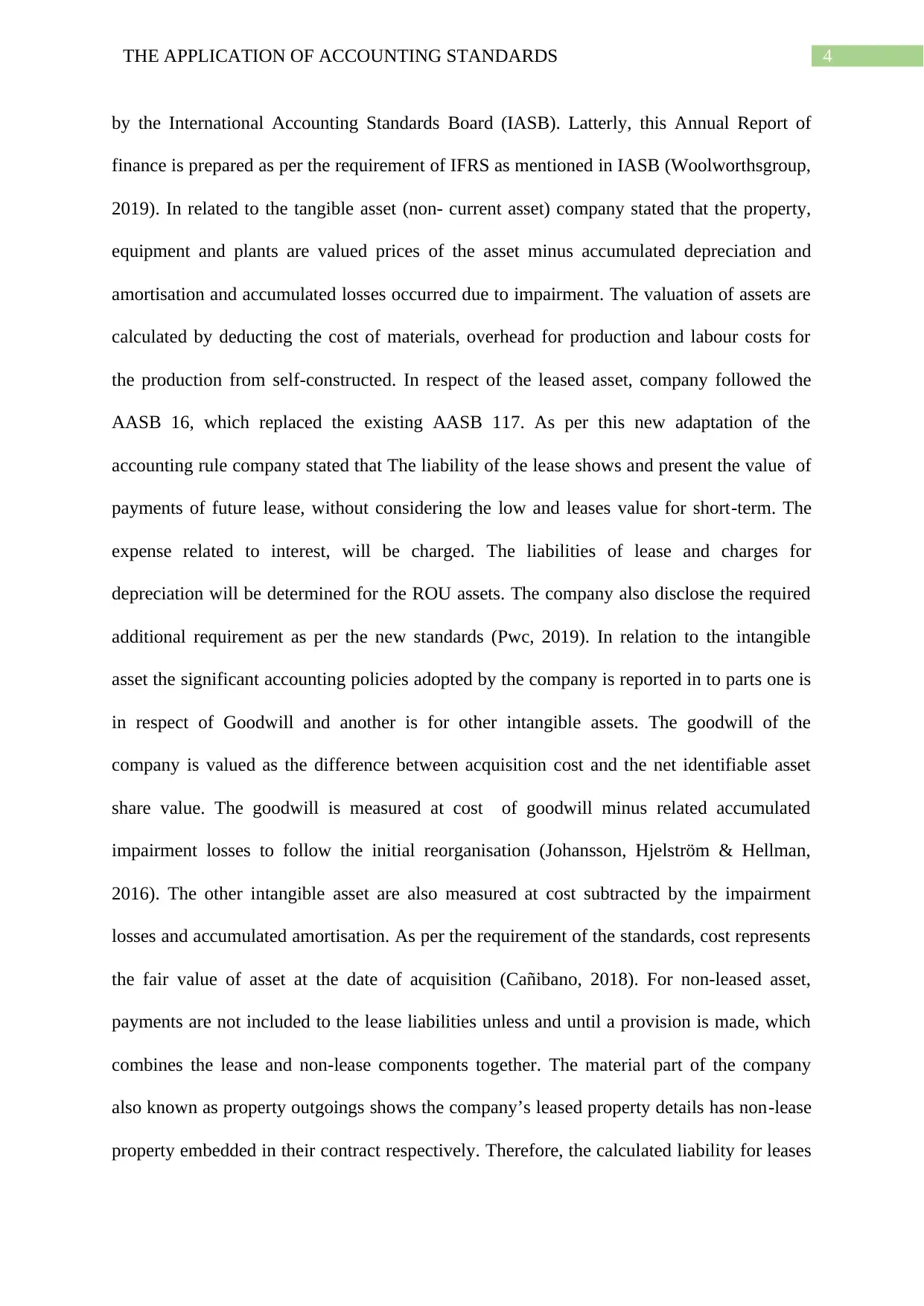
4THE APPLICATION OF ACCOUNTING STANDARDS
by the International Accounting Standards Board (IASB). Latterly, this Annual Report of
finance is prepared as per the requirement of IFRS as mentioned in IASB (Woolworthsgroup,
2019). In related to the tangible asset (non- current asset) company stated that the property,
equipment and plants are valued prices of the asset minus accumulated depreciation and
amortisation and accumulated losses occurred due to impairment. The valuation of assets are
calculated by deducting the cost of materials, overhead for production and labour costs for
the production from self-constructed. In respect of the leased asset, company followed the
AASB 16, which replaced the existing AASB 117. As per this new adaptation of the
accounting rule company stated that The liability of the lease shows and present the value of
payments of future lease, without considering the low and leases value for short-term. The
expense related to interest, will be charged. The liabilities of lease and charges for
depreciation will be determined for the ROU assets. The company also disclose the required
additional requirement as per the new standards (Pwc, 2019). In relation to the intangible
asset the significant accounting policies adopted by the company is reported in to parts one is
in respect of Goodwill and another is for other intangible assets. The goodwill of the
company is valued as the difference between acquisition cost and the net identifiable asset
share value. The goodwill is measured at cost of goodwill minus related accumulated
impairment losses to follow the initial reorganisation (Johansson, Hjelström & Hellman,
2016). The other intangible asset are also measured at cost subtracted by the impairment
losses and accumulated amortisation. As per the requirement of the standards, cost represents
the fair value of asset at the date of acquisition (Cañibano, 2018). For non-leased asset,
payments are not included to the lease liabilities unless and until a provision is made, which
combines the lease and non-lease components together. The material part of the company
also known as property outgoings shows the company’s leased property details has non-lease
property embedded in their contract respectively. Therefore, the calculated liability for leases
by the International Accounting Standards Board (IASB). Latterly, this Annual Report of
finance is prepared as per the requirement of IFRS as mentioned in IASB (Woolworthsgroup,
2019). In related to the tangible asset (non- current asset) company stated that the property,
equipment and plants are valued prices of the asset minus accumulated depreciation and
amortisation and accumulated losses occurred due to impairment. The valuation of assets are
calculated by deducting the cost of materials, overhead for production and labour costs for
the production from self-constructed. In respect of the leased asset, company followed the
AASB 16, which replaced the existing AASB 117. As per this new adaptation of the
accounting rule company stated that The liability of the lease shows and present the value of
payments of future lease, without considering the low and leases value for short-term. The
expense related to interest, will be charged. The liabilities of lease and charges for
depreciation will be determined for the ROU assets. The company also disclose the required
additional requirement as per the new standards (Pwc, 2019). In relation to the intangible
asset the significant accounting policies adopted by the company is reported in to parts one is
in respect of Goodwill and another is for other intangible assets. The goodwill of the
company is valued as the difference between acquisition cost and the net identifiable asset
share value. The goodwill is measured at cost of goodwill minus related accumulated
impairment losses to follow the initial reorganisation (Johansson, Hjelström & Hellman,
2016). The other intangible asset are also measured at cost subtracted by the impairment
losses and accumulated amortisation. As per the requirement of the standards, cost represents
the fair value of asset at the date of acquisition (Cañibano, 2018). For non-leased asset,
payments are not included to the lease liabilities unless and until a provision is made, which
combines the lease and non-lease components together. The material part of the company
also known as property outgoings shows the company’s leased property details has non-lease
property embedded in their contract respectively. Therefore, the calculated liability for leases
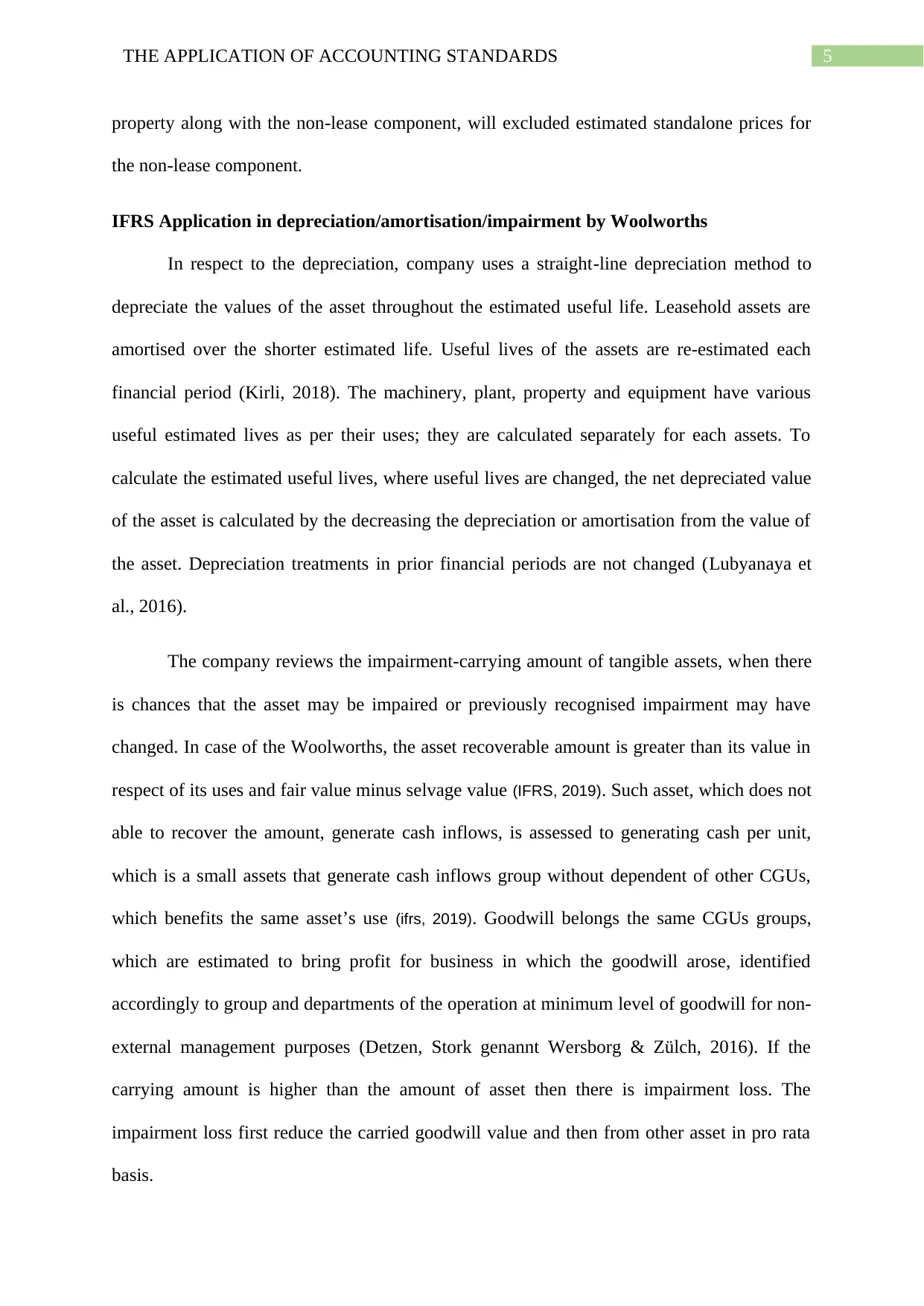
5THE APPLICATION OF ACCOUNTING STANDARDS
property along with the non-lease component, will excluded estimated standalone prices for
the non-lease component.
IFRS Application in depreciation/amortisation/impairment by Woolworths
In respect to the depreciation, company uses a straight-line depreciation method to
depreciate the values of the asset throughout the estimated useful life. Leasehold assets are
amortised over the shorter estimated life. Useful lives of the assets are re-estimated each
financial period (Kirli, 2018). The machinery, plant, property and equipment have various
useful estimated lives as per their uses; they are calculated separately for each assets. To
calculate the estimated useful lives, where useful lives are changed, the net depreciated value
of the asset is calculated by the decreasing the depreciation or amortisation from the value of
the asset. Depreciation treatments in prior financial periods are not changed (Lubyanaya et
al., 2016).
The company reviews the impairment-carrying amount of tangible assets, when there
is chances that the asset may be impaired or previously recognised impairment may have
changed. In case of the Woolworths, the asset recoverable amount is greater than its value in
respect of its uses and fair value minus selvage value (IFRS, 2019). Such asset, which does not
able to recover the amount, generate cash inflows, is assessed to generating cash per unit,
which is a small assets that generate cash inflows group without dependent of other CGUs,
which benefits the same asset’s use (ifrs, 2019). Goodwill belongs the same CGUs groups,
which are estimated to bring profit for business in which the goodwill arose, identified
accordingly to group and departments of the operation at minimum level of goodwill for non-
external management purposes (Detzen, Stork genannt Wersborg & Zülch, 2016). If the
carrying amount is higher than the amount of asset then there is impairment loss. The
impairment loss first reduce the carried goodwill value and then from other asset in pro rata
basis.
property along with the non-lease component, will excluded estimated standalone prices for
the non-lease component.
IFRS Application in depreciation/amortisation/impairment by Woolworths
In respect to the depreciation, company uses a straight-line depreciation method to
depreciate the values of the asset throughout the estimated useful life. Leasehold assets are
amortised over the shorter estimated life. Useful lives of the assets are re-estimated each
financial period (Kirli, 2018). The machinery, plant, property and equipment have various
useful estimated lives as per their uses; they are calculated separately for each assets. To
calculate the estimated useful lives, where useful lives are changed, the net depreciated value
of the asset is calculated by the decreasing the depreciation or amortisation from the value of
the asset. Depreciation treatments in prior financial periods are not changed (Lubyanaya et
al., 2016).
The company reviews the impairment-carrying amount of tangible assets, when there
is chances that the asset may be impaired or previously recognised impairment may have
changed. In case of the Woolworths, the asset recoverable amount is greater than its value in
respect of its uses and fair value minus selvage value (IFRS, 2019). Such asset, which does not
able to recover the amount, generate cash inflows, is assessed to generating cash per unit,
which is a small assets that generate cash inflows group without dependent of other CGUs,
which benefits the same asset’s use (ifrs, 2019). Goodwill belongs the same CGUs groups,
which are estimated to bring profit for business in which the goodwill arose, identified
accordingly to group and departments of the operation at minimum level of goodwill for non-
external management purposes (Detzen, Stork genannt Wersborg & Zülch, 2016). If the
carrying amount is higher than the amount of asset then there is impairment loss. The
impairment loss first reduce the carried goodwill value and then from other asset in pro rata
basis.
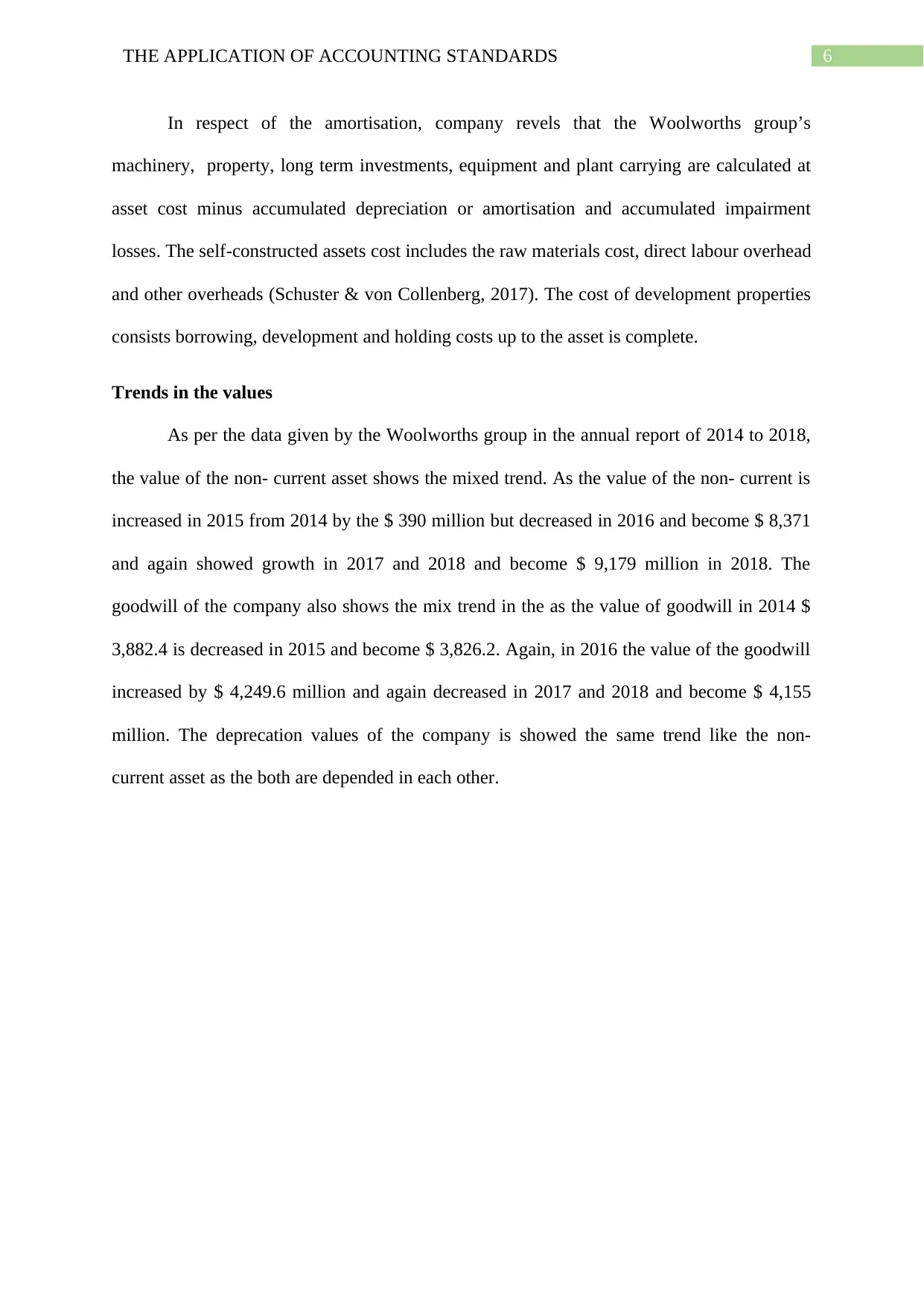
6THE APPLICATION OF ACCOUNTING STANDARDS
In respect of the amortisation, company revels that the Woolworths group’s
machinery, property, long term investments, equipment and plant carrying are calculated at
asset cost minus accumulated depreciation or amortisation and accumulated impairment
losses. The self-constructed assets cost includes the raw materials cost, direct labour overhead
and other overheads (Schuster & von Collenberg, 2017). The cost of development properties
consists borrowing, development and holding costs up to the asset is complete.
Trends in the values
As per the data given by the Woolworths group in the annual report of 2014 to 2018,
the value of the non- current asset shows the mixed trend. As the value of the non- current is
increased in 2015 from 2014 by the $ 390 million but decreased in 2016 and become $ 8,371
and again showed growth in 2017 and 2018 and become $ 9,179 million in 2018. The
goodwill of the company also shows the mix trend in the as the value of goodwill in 2014 $
3,882.4 is decreased in 2015 and become $ 3,826.2. Again, in 2016 the value of the goodwill
increased by $ 4,249.6 million and again decreased in 2017 and 2018 and become $ 4,155
million. The deprecation values of the company is showed the same trend like the non-
current asset as the both are depended in each other.
In respect of the amortisation, company revels that the Woolworths group’s
machinery, property, long term investments, equipment and plant carrying are calculated at
asset cost minus accumulated depreciation or amortisation and accumulated impairment
losses. The self-constructed assets cost includes the raw materials cost, direct labour overhead
and other overheads (Schuster & von Collenberg, 2017). The cost of development properties
consists borrowing, development and holding costs up to the asset is complete.
Trends in the values
As per the data given by the Woolworths group in the annual report of 2014 to 2018,
the value of the non- current asset shows the mixed trend. As the value of the non- current is
increased in 2015 from 2014 by the $ 390 million but decreased in 2016 and become $ 8,371
and again showed growth in 2017 and 2018 and become $ 9,179 million in 2018. The
goodwill of the company also shows the mix trend in the as the value of goodwill in 2014 $
3,882.4 is decreased in 2015 and become $ 3,826.2. Again, in 2016 the value of the goodwill
increased by $ 4,249.6 million and again decreased in 2017 and 2018 and become $ 4,155
million. The deprecation values of the company is showed the same trend like the non-
current asset as the both are depended in each other.
Paraphrase This Document
Need a fresh take? Get an instant paraphrase of this document with our AI Paraphraser
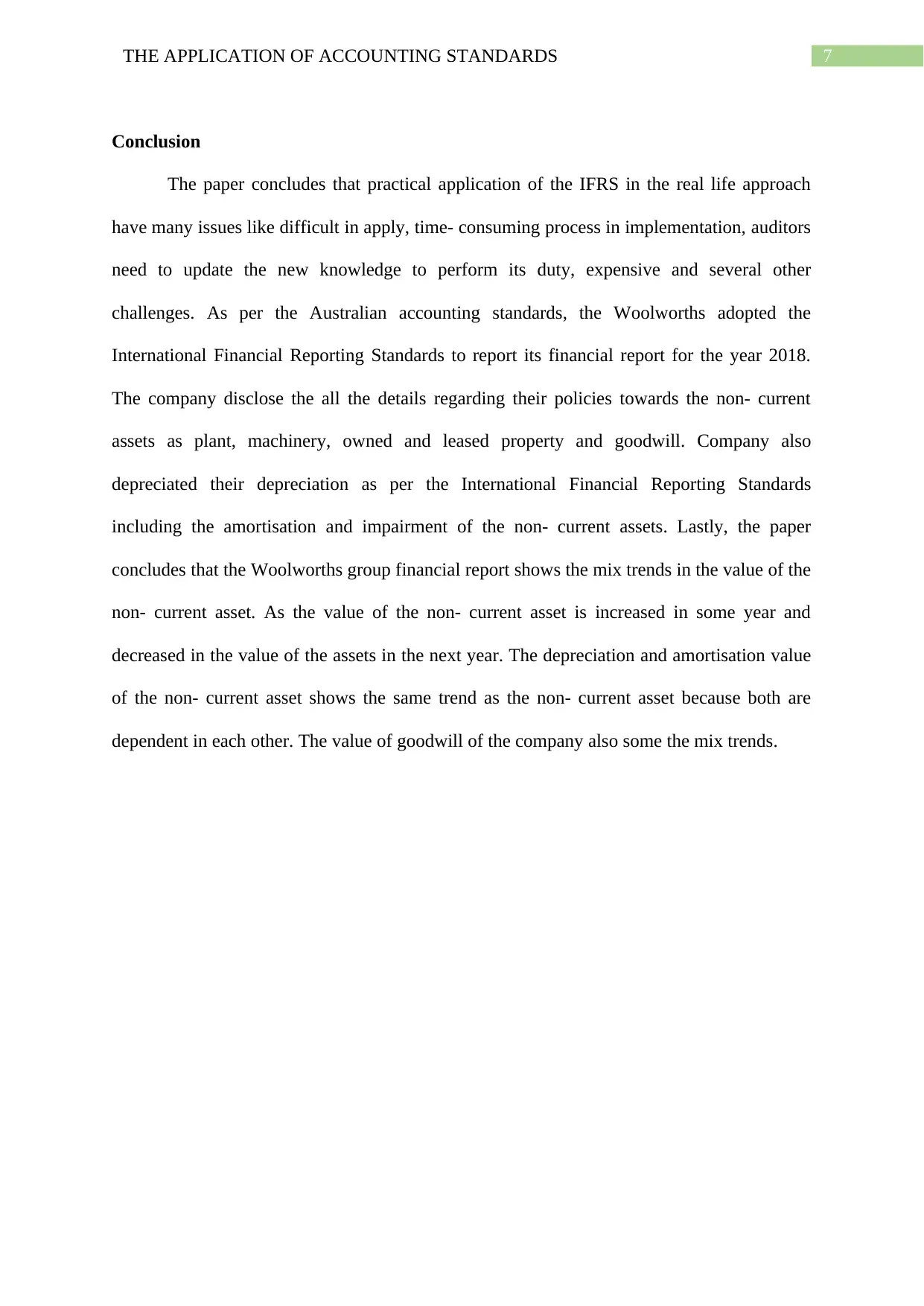
7THE APPLICATION OF ACCOUNTING STANDARDS
Conclusion
The paper concludes that practical application of the IFRS in the real life approach
have many issues like difficult in apply, time- consuming process in implementation, auditors
need to update the new knowledge to perform its duty, expensive and several other
challenges. As per the Australian accounting standards, the Woolworths adopted the
International Financial Reporting Standards to report its financial report for the year 2018.
The company disclose the all the details regarding their policies towards the non- current
assets as plant, machinery, owned and leased property and goodwill. Company also
depreciated their depreciation as per the International Financial Reporting Standards
including the amortisation and impairment of the non- current assets. Lastly, the paper
concludes that the Woolworths group financial report shows the mix trends in the value of the
non- current asset. As the value of the non- current asset is increased in some year and
decreased in the value of the assets in the next year. The depreciation and amortisation value
of the non- current asset shows the same trend as the non- current asset because both are
dependent in each other. The value of goodwill of the company also some the mix trends.
Conclusion
The paper concludes that practical application of the IFRS in the real life approach
have many issues like difficult in apply, time- consuming process in implementation, auditors
need to update the new knowledge to perform its duty, expensive and several other
challenges. As per the Australian accounting standards, the Woolworths adopted the
International Financial Reporting Standards to report its financial report for the year 2018.
The company disclose the all the details regarding their policies towards the non- current
assets as plant, machinery, owned and leased property and goodwill. Company also
depreciated their depreciation as per the International Financial Reporting Standards
including the amortisation and impairment of the non- current assets. Lastly, the paper
concludes that the Woolworths group financial report shows the mix trends in the value of the
non- current asset. As the value of the non- current asset is increased in some year and
decreased in the value of the assets in the next year. The depreciation and amortisation value
of the non- current asset shows the same trend as the non- current asset because both are
dependent in each other. The value of goodwill of the company also some the mix trends.
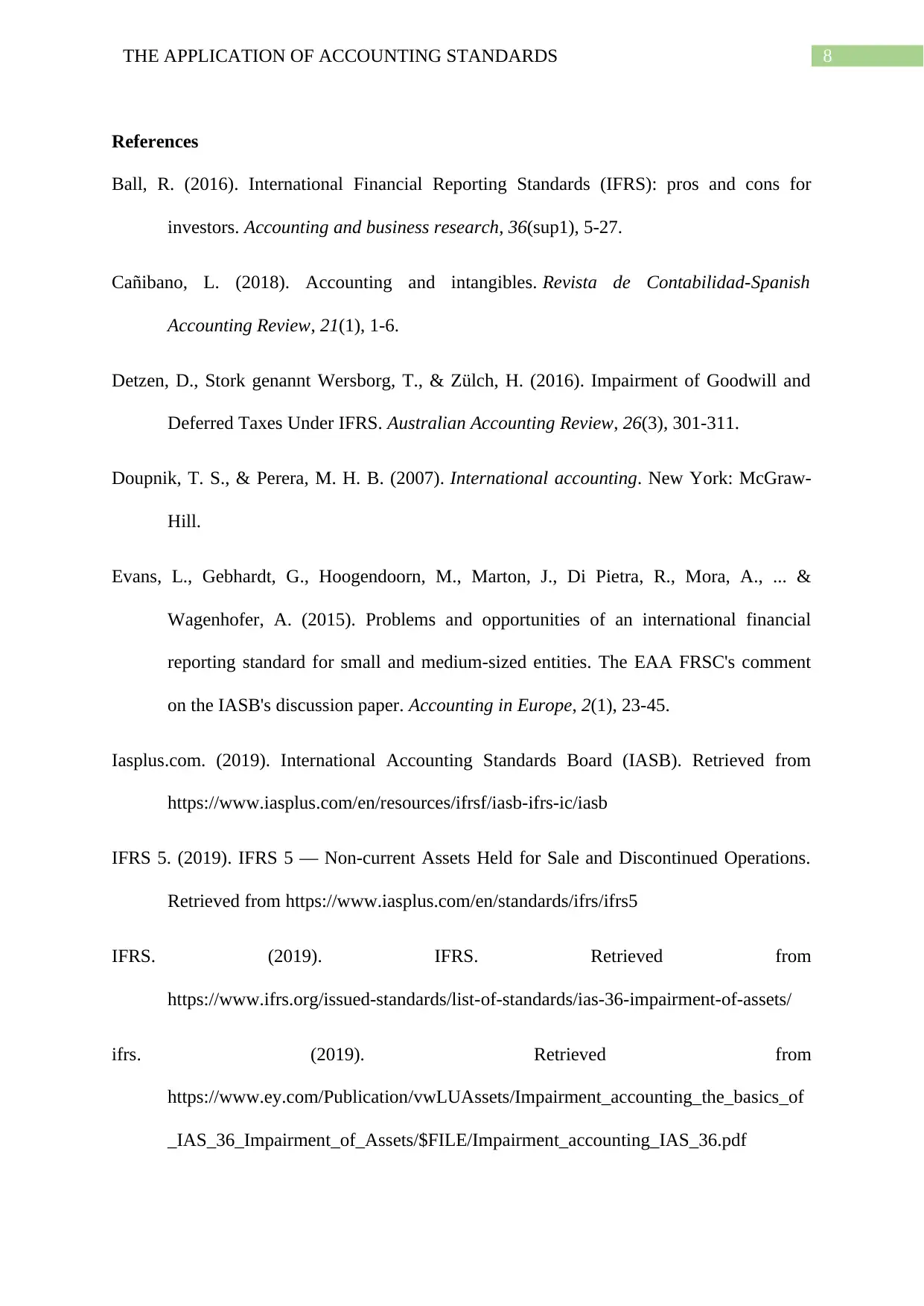
8THE APPLICATION OF ACCOUNTING STANDARDS
References
Ball, R. (2016). International Financial Reporting Standards (IFRS): pros and cons for
investors. Accounting and business research, 36(sup1), 5-27.
Cañibano, L. (2018). Accounting and intangibles. Revista de Contabilidad-Spanish
Accounting Review, 21(1), 1-6.
Detzen, D., Stork genannt Wersborg, T., & Zülch, H. (2016). Impairment of Goodwill and
Deferred Taxes Under IFRS. Australian Accounting Review, 26(3), 301-311.
Doupnik, T. S., & Perera, M. H. B. (2007). International accounting. New York: McGraw-
Hill.
Evans, L., Gebhardt, G., Hoogendoorn, M., Marton, J., Di Pietra, R., Mora, A., ... &
Wagenhofer, A. (2015). Problems and opportunities of an international financial
reporting standard for small and medium-sized entities. The EAA FRSC's comment
on the IASB's discussion paper. Accounting in Europe, 2(1), 23-45.
Iasplus.com. (2019). International Accounting Standards Board (IASB). Retrieved from
https://www.iasplus.com/en/resources/ifrsf/iasb-ifrs-ic/iasb
IFRS 5. (2019). IFRS 5 — Non-current Assets Held for Sale and Discontinued Operations.
Retrieved from https://www.iasplus.com/en/standards/ifrs/ifrs5
IFRS. (2019). IFRS. Retrieved from
https://www.ifrs.org/issued-standards/list-of-standards/ias-36-impairment-of-assets/
ifrs. (2019). Retrieved from
https://www.ey.com/Publication/vwLUAssets/Impairment_accounting_the_basics_of
_IAS_36_Impairment_of_Assets/$FILE/Impairment_accounting_IAS_36.pdf
References
Ball, R. (2016). International Financial Reporting Standards (IFRS): pros and cons for
investors. Accounting and business research, 36(sup1), 5-27.
Cañibano, L. (2018). Accounting and intangibles. Revista de Contabilidad-Spanish
Accounting Review, 21(1), 1-6.
Detzen, D., Stork genannt Wersborg, T., & Zülch, H. (2016). Impairment of Goodwill and
Deferred Taxes Under IFRS. Australian Accounting Review, 26(3), 301-311.
Doupnik, T. S., & Perera, M. H. B. (2007). International accounting. New York: McGraw-
Hill.
Evans, L., Gebhardt, G., Hoogendoorn, M., Marton, J., Di Pietra, R., Mora, A., ... &
Wagenhofer, A. (2015). Problems and opportunities of an international financial
reporting standard for small and medium-sized entities. The EAA FRSC's comment
on the IASB's discussion paper. Accounting in Europe, 2(1), 23-45.
Iasplus.com. (2019). International Accounting Standards Board (IASB). Retrieved from
https://www.iasplus.com/en/resources/ifrsf/iasb-ifrs-ic/iasb
IFRS 5. (2019). IFRS 5 — Non-current Assets Held for Sale and Discontinued Operations.
Retrieved from https://www.iasplus.com/en/standards/ifrs/ifrs5
IFRS. (2019). IFRS. Retrieved from
https://www.ifrs.org/issued-standards/list-of-standards/ias-36-impairment-of-assets/
ifrs. (2019). Retrieved from
https://www.ey.com/Publication/vwLUAssets/Impairment_accounting_the_basics_of
_IAS_36_Impairment_of_Assets/$FILE/Impairment_accounting_IAS_36.pdf
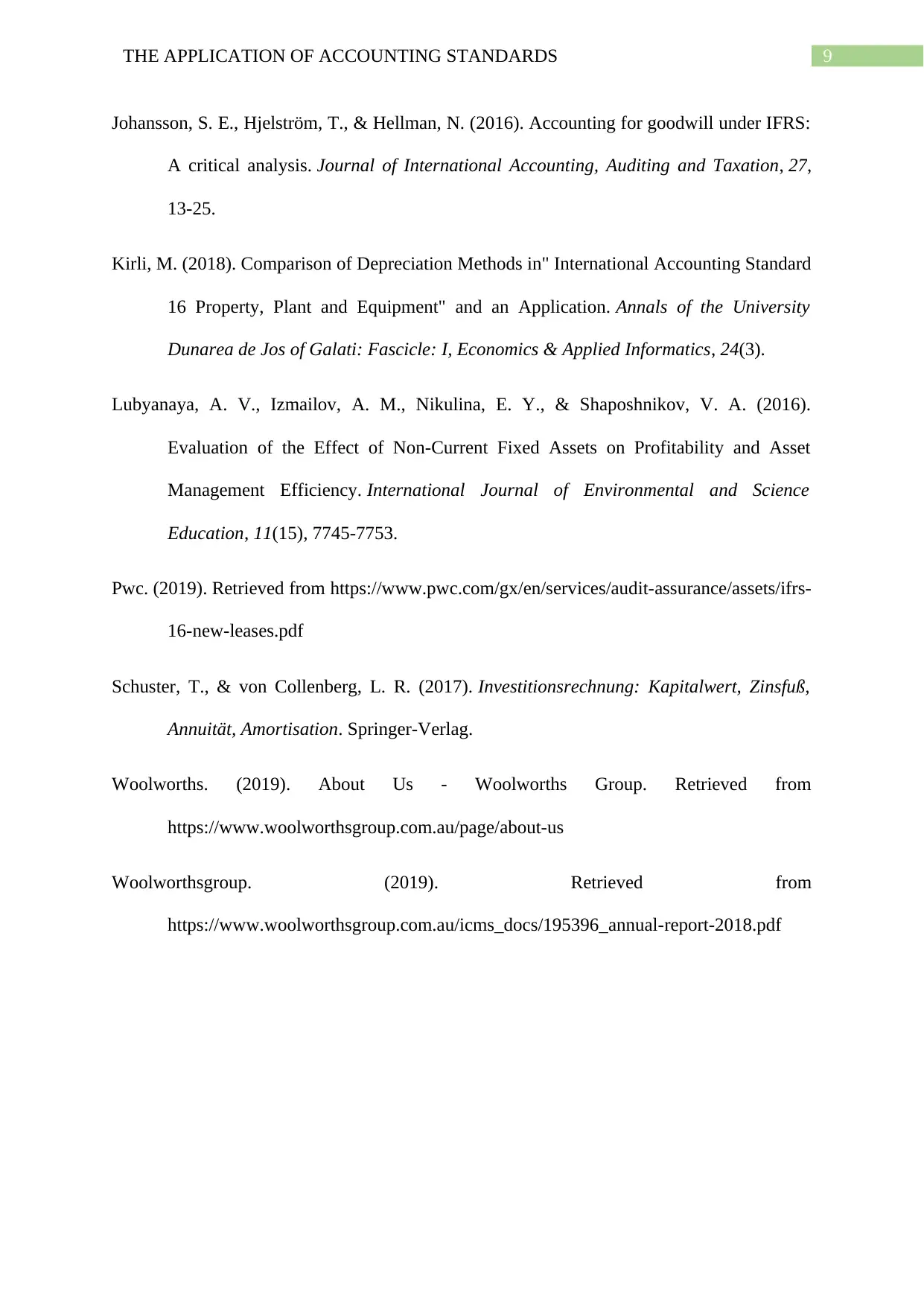
9THE APPLICATION OF ACCOUNTING STANDARDS
Johansson, S. E., Hjelström, T., & Hellman, N. (2016). Accounting for goodwill under IFRS:
A critical analysis. Journal of International Accounting, Auditing and Taxation, 27,
13-25.
Kirli, M. (2018). Comparison of Depreciation Methods in" International Accounting Standard
16 Property, Plant and Equipment" and an Application. Annals of the University
Dunarea de Jos of Galati: Fascicle: I, Economics & Applied Informatics, 24(3).
Lubyanaya, A. V., Izmailov, A. M., Nikulina, E. Y., & Shaposhnikov, V. A. (2016).
Evaluation of the Effect of Non-Current Fixed Assets on Profitability and Asset
Management Efficiency. International Journal of Environmental and Science
Education, 11(15), 7745-7753.
Pwc. (2019). Retrieved from https://www.pwc.com/gx/en/services/audit-assurance/assets/ifrs-
16-new-leases.pdf
Schuster, T., & von Collenberg, L. R. (2017). Investitionsrechnung: Kapitalwert, Zinsfuß,
Annuität, Amortisation. Springer-Verlag.
Woolworths. (2019). About Us - Woolworths Group. Retrieved from
https://www.woolworthsgroup.com.au/page/about-us
Woolworthsgroup. (2019). Retrieved from
https://www.woolworthsgroup.com.au/icms_docs/195396_annual-report-2018.pdf
Johansson, S. E., Hjelström, T., & Hellman, N. (2016). Accounting for goodwill under IFRS:
A critical analysis. Journal of International Accounting, Auditing and Taxation, 27,
13-25.
Kirli, M. (2018). Comparison of Depreciation Methods in" International Accounting Standard
16 Property, Plant and Equipment" and an Application. Annals of the University
Dunarea de Jos of Galati: Fascicle: I, Economics & Applied Informatics, 24(3).
Lubyanaya, A. V., Izmailov, A. M., Nikulina, E. Y., & Shaposhnikov, V. A. (2016).
Evaluation of the Effect of Non-Current Fixed Assets on Profitability and Asset
Management Efficiency. International Journal of Environmental and Science
Education, 11(15), 7745-7753.
Pwc. (2019). Retrieved from https://www.pwc.com/gx/en/services/audit-assurance/assets/ifrs-
16-new-leases.pdf
Schuster, T., & von Collenberg, L. R. (2017). Investitionsrechnung: Kapitalwert, Zinsfuß,
Annuität, Amortisation. Springer-Verlag.
Woolworths. (2019). About Us - Woolworths Group. Retrieved from
https://www.woolworthsgroup.com.au/page/about-us
Woolworthsgroup. (2019). Retrieved from
https://www.woolworthsgroup.com.au/icms_docs/195396_annual-report-2018.pdf
1 out of 10
Related Documents
Your All-in-One AI-Powered Toolkit for Academic Success.
+13062052269
info@desklib.com
Available 24*7 on WhatsApp / Email
![[object Object]](/_next/static/media/star-bottom.7253800d.svg)
Unlock your academic potential
© 2024 | Zucol Services PVT LTD | All rights reserved.




